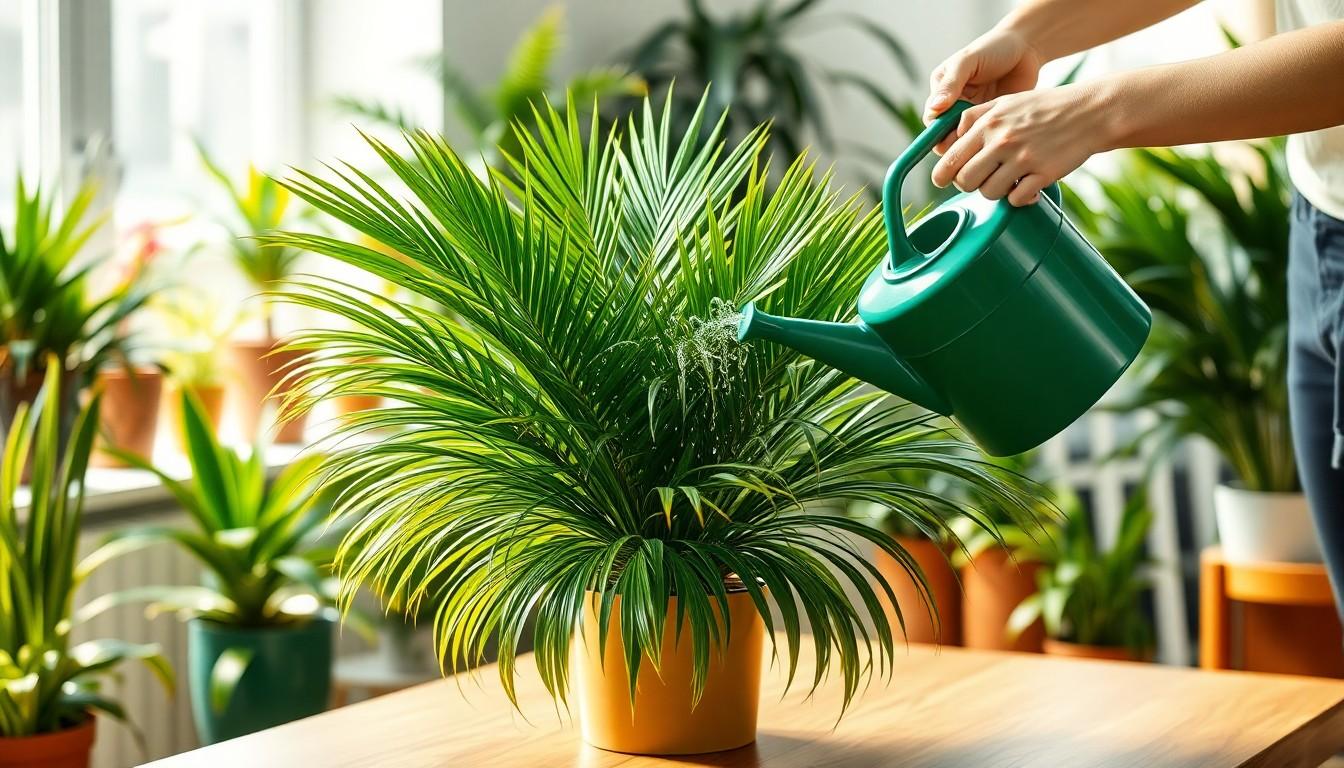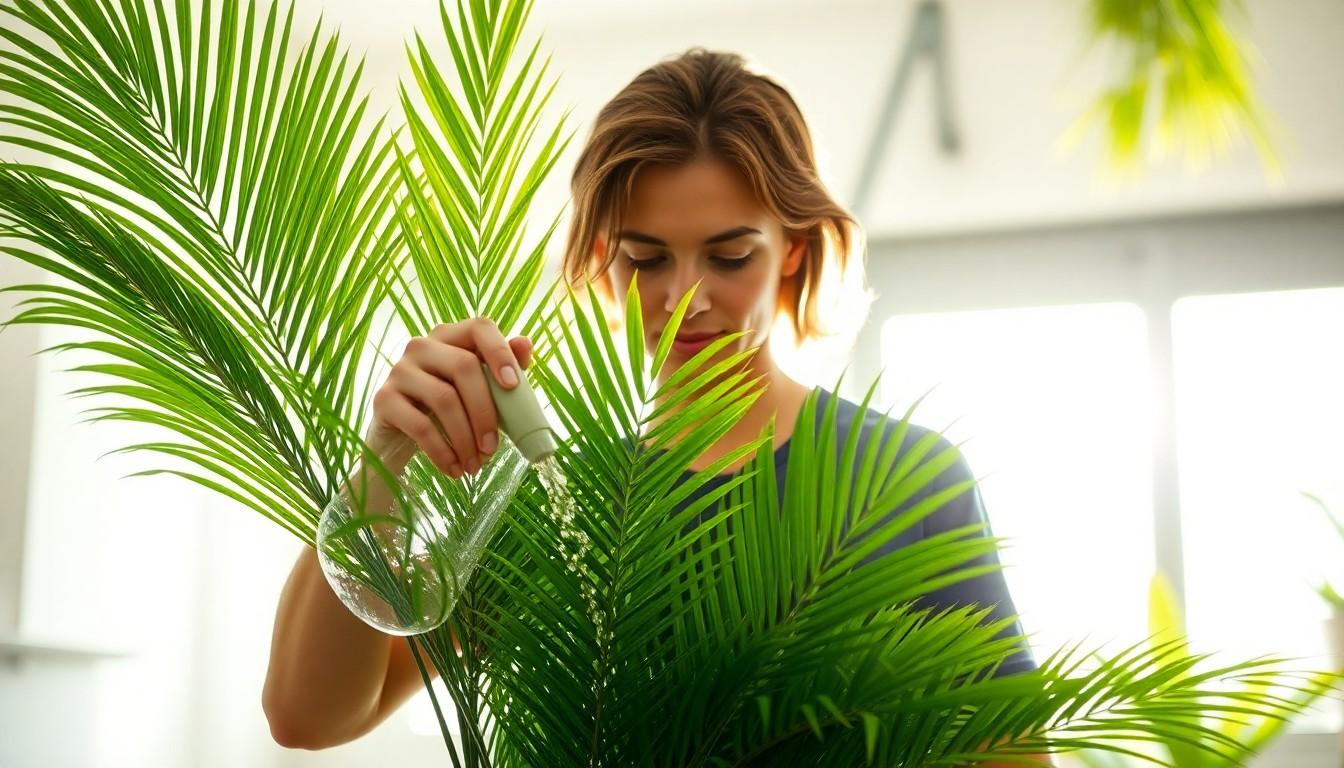Palm plants are the ultimate tropical vibe creators, effortlessly transforming any dull space into a lush paradise. Whether you’re dreaming of a beach getaway or just trying to escape the daily grind, these leafy wonders
plant care can make your home feel like a permanent vacation. But before you start imagining yourself sipping a piña colada under their fronds, it’s crucial to know how to keep them thriving.
How to Care for a Palm Plant
Palm plants bring a touch of the tropics to indoor spaces, enhancing the ambiance and aesthetic appeal. Familiarity with their needs ensures they flourish in various environments.
Popular Types of Palm Plants
Numerous palm species thrive as houseplants. Some common types include:
-
- Areca Palm – Known for its feathery fronds, this palm adds lush greenery to any room.
-
- Kentia Palm – Valued for its elegant, arching leaves, this variety grows well in low-light conditions.
-
- Ponytail Palm – Distinct for its bulbous trunk and long, flowing leaves, this plant offers a unique visual appeal.
-
- Parlor Palm – A small palm with delicate fronds, it suits smaller spaces and thrives in indirect light.
-
- Majesty Palm – Recognized for its tall stature and graceful appearance, it requires higher humidity levels.
Ideal Growing Conditions
Palm plants thrive under specific growing conditions. Bright, indirect light benefits most varieties but direct sunlight can scorch leaves. Humidity levels should remain high, typically above 50%, to prevent leaf browning. Soil consistency matters; a well-draining mix promotes healthy root growth. Watering practices also play a crucial role; the top inch of soil must dry out between waterings to avoid overwatering. A temperature range of 65°F to 80°F encourages optimal growth, favoring warmth and avoiding cold drafts.
Watering Your Palm Plant
Caring for palm plants includes mastering proper watering techniques. Consistency in watering helps maintain healthy growth and vibrant foliage.
Frequency and Amount
Watering frequency varies based on environmental conditions. Generally, a palm plant requires watering every 1 to 2 weeks. When the top inch of soil feels dry, it’s time to water. During warmer months, plants may need more frequent watering, while they need less during winter. Aim to provide enough water to saturate the soil but avoid water pooling. Over time, adjust the amounts based on humidity levels and soil absorption.
Signs of Overwatering and Underwatering
Identifying the signs of stress in palm plants aids in effective care. Overwatered plants display yellowing leaves, a mushy trunk, or mold on the soil surface. Conversely, underwatered plants show brown tips, curling leaves, and wilting. Checking the soil moisture before watering helps prevent these issues. Use a moisture meter for accuracy or insert a finger into the soil to gauge wetness. Adjust watering habits based on these observations to restore vitality to the palm plant.
Light Requirements
Palm plants thrive in bright, indirect light, essential for their growth and health. The right amount of light supports lush foliage and overall vitality.
Best Light Conditions for Different Types
Areca Palms prefer bright, filtered light, which encourages its feathery fronds to flourish. Kentia Palms adapt well, tolerating lower light conditions while still growing steadily. Ponytail Palms enjoy bright light, enhancing their unique, curly leaves. Parlor Palms thrive in low light but benefit from occasional indirect light to promote growth. Majesty Palms achieve optimal growth in bright, indirect light, ensuring strong, upright growth.
Tips for Indoor vs. Outdoor Palm Plants
Indoor palm plants often require placement near east or west-facing windows, maximizing exposure to indirect sunlight. Adjust artificial lighting if natural light is insufficient, using fluorescent grow lights as needed. Outdoor palm plants flourish under dappled sunlight or partial shade, protecting them from harsh midday rays. During hot seasons, ensure adequate hydration and monitor exposure to prevent sunburn on foliage.
Soil and Fertilization
Soil quality and proper fertilization play crucial roles in the health of palm plants. The right soil ensures adequate drainage and aeration, supporting root development.
Choosing the Right Soil
Selecting a well-draining potting mix is vital for palm plants. Use a blend specifically designed for palm or tropical plants, which typically includes ingredients like peat moss, perlite, or sand. The mix should retain some moisture while allowing excess water to escape. A soil pH between 6 and 7 promotes optimal growth. Regularly checking drainage holes in pots helps prevent root rot, ensuring the palm thrives in its environment.
Recommended Fertilizers and Feeding Schedule
Fertilizing palm plants maintains their vibrant foliage and overall health. A balanced liquid fertilizer with equal parts nitrogen, phosphorus, and potassium works well. Apply the fertilizer at half-strength every four to six weeks during the growing season, typically spring and summer. During autumn and winter, reduce or stop fertilization to allow the plant to rest. Observing leaf color can indicate nutrient needs; yellowing may signal a need for more nutrients.
Pruning and Maintenance
Pruning and maintenance play significant roles in keeping palm plants healthy and attractive. Regular attention to these tasks promotes growth and reduces the risk of pests.
When and How to Prune
Pruning palm plants enhances their appearance and encourages new growth. Trim dead or yellowing fronds regularly to maintain a tidy look. It’s best to prune in early spring before the growing season begins. Use clean, sharp tools to prevent damage and infection. Taking care to cut close to the trunk without injuring it benefits the overall health of the plant. Additionally, avoid excessive pruning, as this can impede growth.
Common Pests and Diseases
Pest management and disease prevention ensure palm plants remain vibrant. Common pests include spider mites, mealybugs, and scale insects, which can weaken the plant. Monitoring leaves for signs of infestation helps in early detection. Treat visible pests with insecticidal soap or neem oil, applying it according to the manufacturer’s instructions. Fungal infections often manifest through yellowing leaves or spots. Maintaining proper humidity and airflow around the plant minimizes disease risks. Keeping the environment clean prevents pests from returning, ensuring healthy palm plants.
Ensuring Palm Thrives
Caring for palm plants is a rewarding endeavor that brings a touch of the tropics into any home. By following the right practices for light, watering, soil, and maintenance, anyone can ensure their palm thrives. Regular observation and adjustments based on the plant’s needs will lead to vibrant foliage and overall health.
With the right attention and care, palm plants can flourish, transforming indoor spaces into lush, inviting environments. Embracing these simple yet effective care tips will not only enhance the beauty of the plants but also contribute to a relaxing atmosphere reminiscent of a serene getaway.



